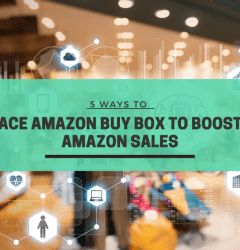This website uses cookies so that we can provide you with the best user experience possible. Cookie information is stored in your browser and performs functions such as recognising you when you return to our website and helping our team to understand which sections of the website you find most interesting and useful.
02 Sep

Learn Step-by-Step Guide on How to Sell Trending Products on Amazon
Amazon is a highly competitive platform, and selling the right product ahead of the competition can be a tricky affair. Even finding the right product can be a challenge for many sellers. Decide on selling something too popular, and the competition is a tough nut to crack; or select something very niche, and probably no one actually needs it or has even heard of it before!
Offering the right products at the right time is one of the most critical aspects of selling successfully on Amazon. About 53% of the US adults now start their product searches on Amazon when wanting to make an online purchase, as against only 23% who start off first with search engines like Google or Bing. However, many sellers are unable to sail during these difficult times as they find it difficult to maintain a record of the products gaining popularity. Given the fierce competition and the availability of a myriad of products in the market, it becomes a complicated task.
In this blog, we are going to deep dive into some key aspects to assess the market opportunity of a trending product.
1) Product Research -
Find out what buyers are looking for online, and identify a gap in the market. One of the best ways to do this is through manual research for trending ideas on Amazon (more on this below). For instance, when we simply search for “men’s tracksuits” on Amazon.com, there are about 4000 results; while when searched for “men’s track pants”, we are down to only 600 results. This is a very simplified example, but such small tricks can help you explore a category and then narrow it down to a niche.
Furthermore, when a product has many popular or highly searched for keywords, it is an indirect indicator of high purchase intent for the product on Amazon. For example, if the top 3-4 keywords for a product have about 100,000 monthly search volume each, then you know that the product is popular. However, always ensure that you strike a balance between high demand vs. intense competition in the product category.
Another way to identify in-demand products could be through Amazon’s Best Seller Rank. If you find a category that has only one product with a high BSR, while none of the others are best-sellers, this is not a positive sign. So, as a loose guideline, try to look for categories that have 3-4 best seller products on the first page. This indicates that the category is not dominated by a single seller or product.
2) Competition and Market Size -
As a seller, you don’t want to step into a category that has no clear differentiation and highly cut-throat competition. Moreover, the market size should be adequate enough to accommodate new players. Estimating the size of the market, assessing the top players in the category and then benchmarking against these popular competitors, therefore, becomes the foundation of your market entry strategy. For instance, a few of our clients ventured into the designer, reusable face masks category right at the beginning of the pandemic last year, to serve the increasing demand for fashionable hygiene items that are there to stay for the foreseeable future.
The initial growth may require an aggressive push in case your product falls into a particular niche that is yet not established. Sellers must also assess any government regulations or trademark restrictions associated with the products that might not permit you to sell them. Additionally, when trying to gauge the competition in the category, try to analyse the reviews of similar products. For example, if the competitors selling the same product on Amazon have got thousands of reviews, it is an indicator that the category might be very challenging to even begin with.
3) Sourcing -
In case the category is dominated by a few players, with cost and supply-chain advantages on their side, it implies that the barrier to entry is significant. No matter how lucrative a product seems, it will lead to longer delivery periods if you can’t source products on time. However, locally sourced and manufactured products may act to your benefit by reducing your go-to-market time. For instance, one of our clients involved in the bedding category opted for a local supplier to avoid delay. This resulted in reduced lead time for inventory by 50%. Additionally, try to evaluate profitability while considering how to source the product.
4) Cost Considerations -
Evaluation of costs associated with each stage needs to be done when launching a new product. It becomes all the more important, in the case of trending products, to understand the cost of accelerating the efforts. Your bottom line will be directly impacted if sourcing, manufacturing, fulfillment and marketing costs combined form substantial figures to launch it in a given time frame.
Try to choose products that fall in a sweet price spot, and hence, leave room for higher margins. Moderately priced products are usually purchased more impulsively than expensive products, since customers do not usually spend that much time comparing and evaluating their need for the product when it’s not highly priced. But at the same time, do not go for very low priced products either since consumers might associate that with poor product quality. Some other essential cost factors to study here include weight and size of the item, FBA and referral fees, and budget for PPC campaigns. By opting for a smaller or less bulky product, you can manage your shipping costs a lot more easily.
5) Timing and Purchase Frequency -
It is important to think about when your product is going to hit the market while planning to launch a new product. The safest bit is to go for products that have a year-round demand and are unaffected by seasonal fluctuations. However, it is also important to figure out the right time to start working on strategizing in order to capitalize on the demand when the product is at its peak. In case there is a behavioral trend that is gaining momentum, understand what stage the demand is at and make a decision based on when it would get saturated.
High usage frequency products, such as consumables, lead to better recurring revenue cycles. This allows the sellers to invest in product, packaging, supply, and look for the next big thing in that category. For instance, in the current scenario, health and immunity products are witnessing an ever-growing demand.
But, how can you find new products?
Exploring a combination of on-site and off-site channels is one of the best ways to find trending products to sell on Amazon.
Following are some ways to look at Amazon to find new product ideas and inspiration:
- Amazon Best Sellers – Most popular products are displayed across all categories which are updated on an hourly basis. This gives an insight into what is gaining traction in the market and what people are actively searching for.
- Amazon New Releases – In this section, Amazon’s best-selling new and future releases are displayed, which is updated every hour. Tracking of brand new launches from other sellers becomes easier via this section.
- Amazon Movers & Shakers – This section displays products that are the highest gainers in the sales rank in the past 24 hours.
- Customers Also Bought Section – This section can help you get ideas for similar items that customers purchased while looking at a particular product. Tracking such products will not only help you find similar products, but most importantly, complementary items to the main product.
- Google Trends – As a leading discovery platform, Google tells you what people are searching for. This step will help you further substantiate what you have found from the above mentioned tips. Google Trends is a platform that provides results for a particular search query over a period of time. This helps in identifying whether that specific item has a rising interest from the users.
All in all, selling trending products on Amazon can prove to be a profitable move for any seller. However, to launch successfully, sellers must equip themselves with effective preparation and strategy to enter the market. Barriers to entry, market sizing, timing, cost of selling, and seasonality constraints must be critically examined to decide whether the product is suitable for your business.
In case you already have a product idea in mind, utilize the aforementioned tips to further refine your options. If not, begin with basics by studying what people search most on Amazon and off Amazon to keep an eye out for new product opportunities.
Related Post
Industries Served
United States
India













